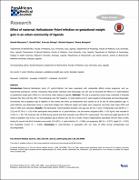| dc.contributor.author | Wanyama, Ronald | |
| dc.contributor.author | Obai, Gerald | |
| dc.contributor.author | Odongo, Pancras | |
| dc.contributor.author | Kagawa, Michael | |
| dc.contributor.author | Baingana, Rhona | |
| dc.date.accessioned | 2021-10-02T21:18:01Z | |
| dc.date.available | 2021-10-02T21:18:01Z | |
| dc.date.issued | 2017 | |
| dc.identifier.citation | Wanyama, R., Obai, G., Odongo, P., Kagawa, M., & Baingana, R. (2017). Effect of maternal Helicobacter Pylori infection on gestational weight gain in an urban community of Uganda. The Pan African Medical Journal, 28. | en_US |
| dc.identifier.uri | http://www.panafrican-med-journal.com/content/article/28/145/full/ | |
| dc.identifier.uri | https://hdl.handle.net/123456789/328 | |
| dc.description.abstract | Introduction: Maternal Helicobacter pylori (H. pylori) infection has been associated with undesirable effects during pregnancy such as;
hyperemesis gravidarum, anemia, intrauterine fetal growth restriction and miscarriage. Our aim was to document the effect of H. pylori infection
on gestational weight gain (GWG) in a low-income urban setting in Uganda. Methods: This was a prospective cohort study conducted in Kampala
between May 2012 and May 2013. The participants were HIV negative, H. pylori positive and H. pylori negative primigravidae and secundigravidae.
Recruitment was at gestation age of eighteen or less weeks and follow up assessments were carried out at 26 and 36 weeks gestation age. H.
pylori infection was determined using H. pylori stool antigen test. Maternal weight and height were measured, and body mass index (BMI) and
rates of GWG were calculated. Results: The participants’ mean±standard deviation (sd) age was 20.9±2.7 years. Primigravidae were 68.8% (n =
132) and 57.3% (n = 110) of the participants were positive for H. pylori infection. Low pre-women pregnancy BMI (< 18.5 kg/m2) was recorded in
14.6% (n = 28). The mean±sd rate of GWG during second and third trimesters was 300.5±79.7 grams/week. The mean±sd weight gained by 36
weeks of gestation was 9.6±2.2 kg while gestation age at delivery was 39.4±1.0 weeks. Factors independently associated with the rates of GWG
during the second and third trimesters were parity (P=0.023), H. pylori infection (P = 0.006), pre-pregnancy BMI (P = 0.037), height (P = 0.022)
and household income (P = 0.003). Conclusion: H. pylori infection is associated with low rates of GWG among primigravidae and
secundigravidae. | en_US |
| dc.language.iso | en | en_US |
| dc.publisher | The Pan African Medical Journal | en_US |
| dc.subject | H. pylori infection | en_US |
| dc.subject | pregnancy | en_US |
| dc.subject | gestational weight gain | en_US |
| dc.subject | parity | en_US |
| dc.subject | Kampala | en_US |
| dc.subject | Uganda | en_US |
| dc.title | Effect of maternal Helicobacter Pylori infection on gestational weight gain in an urban community of Uganda | en_US |
| dc.type | Article | en_US |

